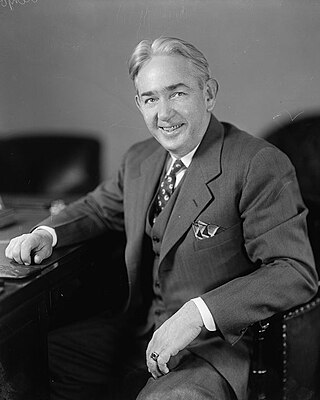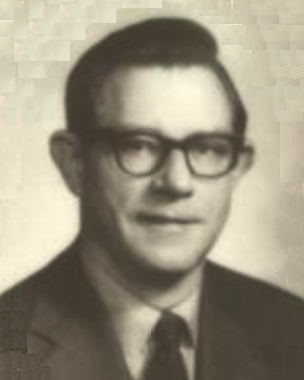Related Research Articles

James Lindsay Almond Jr. was an American lawyer, state and federal judge and Democratic party politician. His political offices included as a member of the U.S. House of Representatives from Virginia's 6th congressional district (1946–1948), 26th Attorney General of Virginia (1948–1957) and the 58th Governor of Virginia (1958–1962). As a member of the Byrd Organization, Almond initially supported massive resistance to the integration of public schools following the United States Supreme Court decisions in Brown v. Board of Education, but when Virginia and federal courts ruled segregation unconstitutional, Almond worked with the legislature to end massive resistance.
Massive resistance was a strategy declared by U.S. senator Harry F. Byrd Sr. of Virginia and his son Harry Jr.'s brother-in-law, James M. Thomson, who represented Alexandria in the Virginia General Assembly, to get the state's white politicians to pass laws and policies to prevent public school desegregation, particularly after Brown v. Board of Education.

The Byrd machine, or Byrd organization, was a political machine of the Democratic Party led by former Governor and U.S. Senator Harry F. Byrd (1887–1966) that dominated Virginia politics for much of the 20th century. From the 1890s until the late 1960s, the Byrd organization effectively controlled the politics of the state through a network of courthouse cliques of local constitutional officers in most of the state's counties.
Lloyd Campbell Bird was a pharmacist, businessman and Democratic politician who served as a Virginia State Senator for 28 years and helped found Virginia Commonwealth University in Richmond.

Albertis Sydney Harrison Jr. was an American politician and jurist. A member of the Democratic Party associated with Virginia's Byrd Organization, he was the 59th Governor of Virginia in 1962–66, and the first governor of Virginia to have been born in the 20th century.

George Moffett Cochran IV was a Virginia lawyer, banker and legislator who later served as a justice of the Virginia Supreme Court. Cochran served part-time representing Staunton, Virginia in the Virginia General Assembly for nearly two decades, first as a delegate, then briefly as state senator. His opposition to the Byrd Organization's policy of Massive Resistance helped integrate Virginia's schools.

Mosby Garland Perrow Jr. was a Virginia lawyer and state senator representing Lynchburg, Virginia. A champion of Virginia's public schools, Perrow became a key figure in Virginia's abandonment of "Massive Resistance" to public school desegregation, including by chairing a joint legislative committee colloquially known as the Perrow Commission.
The Stanley Plan was a package of 13 statutes adopted in September 1956 by the U.S. state of Virginia. The statutes were designed to ensure racial segregation would continue in that state's public schools despite the unanimous ruling of the U.S. Supreme Court in Brown v. Board of Education (1954) that school segregation was unconstitutional. The legislative program was named for Governor Thomas B. Stanley, a Democrat, who proposed the program and successfully pushed for its enactment. The Stanley plan was a critical element in the policy of "massive resistance" to the Brown ruling advocated by U.S. Senator Harry F. Byrd Sr. The plan also included measures designed to curb the Virginia state chapter of the National Association for the Advancement of Colored People (NAACP), which many Virginia segregationists believed was responsible for "stirring up" litigation to integrate the public schools.
Armistead Lloyd Boothe was a Virginia Democratic legislator representing Alexandria, Virginia: first as a delegate in the Virginia General Assembly and later as a State Senator from the newly created 36th District. A lifelong Democrat, Boothe helped lead his party's progressive faction, particularly as they opposed the Byrd Organization's policy of Massive Resistance to racial integration in Virginia's public schools.
Charles Rogers Fenwick was a patent attorney and Virginia Democratic politician aligned with the Byrd Organization who served part-time in the Virginia House of Delegates and Senate representing Arlington County.
Curry Carter was a Virginia Democratic politician from Staunton, Virginia.
Allie Edward Stakes Stephens, usually known as "A. E. S." or "Gi" Stephens, was a Virginia lawyer and Democratic Party politician who served in both houses of the Virginia General Assembly and as the 27th lieutenant governor of Virginia from 1952 to 1962. His state political career ended with a loss in the Democratic primary for Governor in 1961, after he and Governor J. Lindsay Almond broke with the Byrd Organization, which wanted to continue its policy of massive resistance to desegregation of Virginia's schools after both the Virginia Supreme Court and a 3-judge federal panel ruled most elements unconstitutional in 1959.
The Commission on Public Education, known as the VPEC or Gray Commission, was a 32-member commission established by Governor of Virginia Thomas B. Stanley on August 23, 1954 to study the effects of the U.S. Supreme Court decisions in Brown v. Board of Education issued on May 17, 1954 and May 31, 1955, and to make recommendations. Its counsel were David J. Mays and his associate Henry T. Wickham.
Garland Gray was a long-time Democratic member of the Virginia Senate representing Southside Virginia counties, including his native Sussex. A lumber and banking executive, Gray became head of the Democratic Caucus in the Virginia Senate, and vehemently opposed school desegregation after the U.S. Supreme Court decisions in Brown v. Board of Education in 1954 and 1955. Although Senator Harry F. Byrd himself supported Massive Resistance, and preferred Gray over other candidates, the Byrd Organization refused to wholeheartedly support Gray's bid to become the party's gubernatorial candidate in 1957, so J. Lindsay Almond won that party's primary and later the Governorship.

Frederick Thomas Gray was a Virginia attorney and Democratic Party politician. Governor J. Lindsay Almond appointed Gray to serve as Attorney General of Virginia after the resignation of Attorney General Albertis Harrison to run for Governor of Virginia during the Massive Resistance crisis in Virginia. Gray returned to private practice at Williams Mullen after Robert Young Button took office. Gray later served in the Virginia House of Delegates and the Virginia Senate as he continued his law practice.
Robert Young Button served two terms as Attorney General of Virginia, as well as a fifteen years as Virginia State Senator. Button rose through the ranks of the Byrd Organization and became one of its leading members as it ultimately crumbled as a result of the Massive Resistance crisis.
Stuart Barns Carter was a Virginia lawyer, farmer and businessmen who also served as the Democratic legislator representing Botetourt and Craig Counties: first as a delegate in the Virginia General Assembly and later as a State Senator from the 20th District. A lifelong Democrat, Carter helped lead his party's progressive faction, particularly as they opposed the Byrd Organization's policy of Massive Resistance to racial integration in Virginia's public schools.
Earl Abbath Fitzpatrick was a Virginia lawyer and member of the Virginia General Assembly representing Roanoke between 1940 and 1959, first as a delegate and then as a state Senator. A lieutenant in the Byrd Organization, Fitzpatrick was active in the Massive Resistance to racial integration vowed by U.S. Senator Harry F. Byrd after the U.S. Supreme Court decisions in Brown v. Board of Education. He introduced much of the segregationist legislation and was vice-chairman of the Boatwright Committee which investigated the NAACP for litigating on behalf of civil rights, before being defeated in the 1959 Democratic primary.

Sydney Floyd Landreth was an American lawyer, banker and Republican politician from Galax, Virginia who represented the 14th state senatorial district for two decades. He ran unsuccessfully for Governor of Virginia in 1945.

Robert Sidney Burruss Jr. was a state Senator and businessman from Lynchburg, Virginia. In 1963 he became the first Republican elected to represent the area since Congressional Reconstruction.
References
- ↑ E. Griffith Dodson, The General Assembly of Virginia 1939-1960 (Richmond: Virginia State Library 1961) p. 396
- 1 2 Ronald L. Heinemann, Harry Byrd of Virginia (Charlottesville: University of Virginia Press, 1996) at pp. 347–50
- ↑ "Television News of the Civil Rights Era : Primary Documents". virginia.edu. Retrieved October 19, 2016.
- 1 2 "Report on the Commission of Education" (PDF). 1959. Retrieved August 17, 2016.
- ↑ "Members of the Perrow Commission predict passage of their program to safeguard segregated schools". University of Virginia Library. Retrieved October 19, 2016.
- ↑ Heinemann pp.350–351
- 1 2 3 Cochran, George M. (2006). "Virginia Facing Reality: The 1959 Perrow Commission" (PDF). Augusta County Historical Society. Retrieved July 11, 2011.
- ↑ Heinemann p.351
- ↑ Gunter, Margaret B. (2003). "A History of Public Education in Virginia" (PDF). Commonwealth of Virginia Department of Education. Archived from the original (PDF) on September 29, 2011. Retrieved July 11, 2011.
- ↑ Daugherity at p. 109
- ↑ Brian J. Daugherity, Keep on Keeping On (University ofVirginia Press 2016 at 124 et seq.